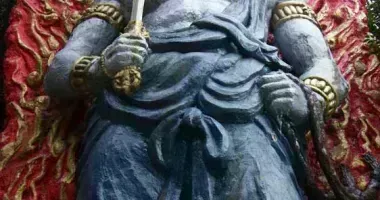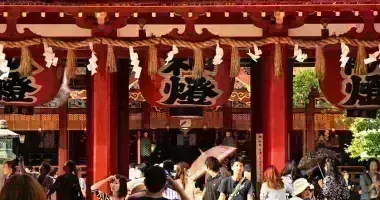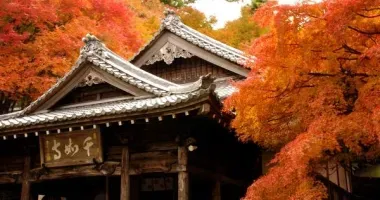Shofukuji Temple Hakata: Japan's first Zen temple and its historical significance
- Published on : 27/06/2024
- by : Japan Experience
- Youtube
Nestled in the heart of Fukuoka's Hakata district, Shofukuji Temple stands as a testament to the birth of Zen Buddhism in Japan. Founded in 1195 by the visionary priest Eisai, this remarkable temple holds the distinction of being the first Zen temple ever constructed on Japanese soil. As you step through its gates, you're not just entering a place of worship, but stepping back in time to witness the dawn of a spiritual revolution that would profoundly shape Japanese culture for centuries to come. From its architectural marvels to its role in shaping Hakata's development, Shofukuji Temple offers a fascinating glimpse into Japan's rich religious and cultural heritage. Join us as we explore the captivating story of this historic landmark and its enduring legacy in the world of Japanese Zen Buddhism.
The founding of Shofukuji Temple and its historical context
The story of Shofukuji Temple begins with the remarkable journey of Eisai, a Buddhist monk who would become the father of Japanese Zen. Born in 1141 in Bitchu province (present-day Okayama Prefecture), Eisai was initially trained in the Tendai sect of Buddhism. However, dissatisfied with what he perceived as the degeneration of Buddhist practice in Japan, he embarked on two pivotal trips to China in search of more authentic teachings.
It was during his second voyage in 1187 that Eisai encountered Chan Buddhism, the Chinese precursor to Zen. Studying under Chan master Xuan Huaichang of the Linji (Rinzai) school, Eisai immersed himself in the meditative practices and philosophical insights that would form the core of Zen Buddhism. Upon his return to Japan in 1191, he brought not only Zen scriptures but also tea plant seeds, inadvertently introducing what would become one of Japan's most iconic cultural elements.
In 1195, with the patronage of the powerful samurai lord Minamoto no Yoritomo, Eisai founded Shofukuji Temple on the site of a former chapel built by Chinese expatriates in Hakata. This location was strategically chosen, as Hakata was a crucial port for trade with China and Korea, making it an ideal entry point for new ideas and practices.
The establishment of Shofukuji marked a significant moment in Japanese religious history. Before Zen's introduction, Buddhism in Japan had already existed for centuries, dating back to the 6th century. However, the new teachings of Zen, with their emphasis on meditation, discipline, and direct experience as the path to enlightenment, offered a fresh perspective that resonated particularly with the samurai class. This appeal to the warrior elite would prove crucial in the spread and influence of Zen throughout Japan.
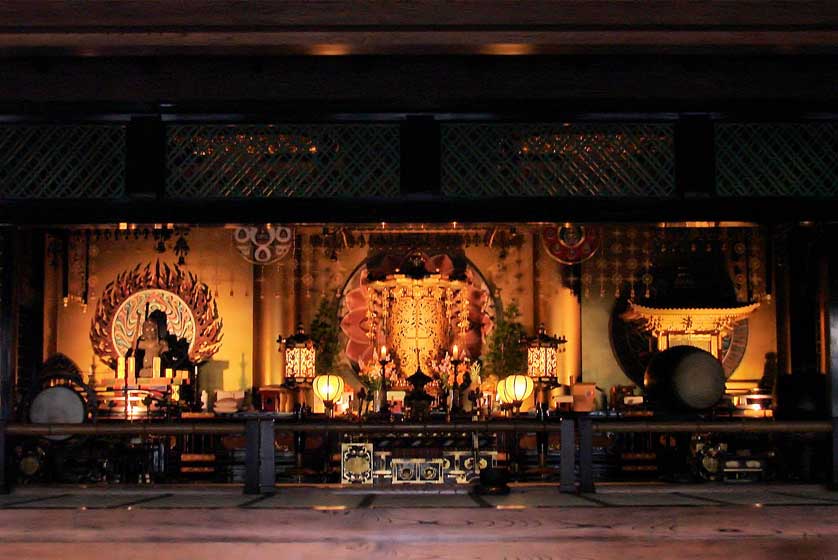
Shofukuji in Fukuoka is the oldest Zen temple in Japan dating from 1195.
Architectural features and layout of Shofukuji Temple
Shofukuji Temple's architecture and layout embody the essence of Zen philosophy, reflecting the simplicity, functionality, and harmony with nature that are hallmarks of Zen aesthetics. While the original structures have been rebuilt numerous times over the centuries due to fires and wars, the current layout still maintains many features typical of a classic Zen temple.
At the heart of the temple complex stands the imposing Sanmon Gate, the most prominent of several temple gates. This large gate, rebuilt in 1911, serves as the main entrance and symbolizes the transition from the mundane world to the sacred space within. In front of the Sanmon Gate, visitors are greeted by a small pond and bridge, elements that are not merely decorative but serve to create a sense of tranquility and reflection as one enters the temple grounds.
Behind the Sanmon Gate, a tree-lined path leads to the Butsuden (Buddha Hall), housing a small wooden statue of the historical Buddha flanked by larger golden Buddha statues. The ceiling of this hall is adorned with a painting of a cloud dragon, a common motif in Zen temples symbolizing the dynamic and elusive nature of enlightenment.
Other significant structures within the temple complex include:
- The Shoro (Bell Tower): Built in 1589 and renovated in 1759, it once housed an important cultural property - a bronze bell from Korea.
- The Hojo (Abbot's Quarters): Originally relocated from Hizen Nagoya Castle in 1601, this building has undergone several renovations over the centuries.
- The Kuri (Temple Kitchen): Constructed in 1589 and renovated in the early 20th century, it played a crucial role in the daily life of the temple.
- The Zendo (Meditation Hall): Moved from a sub-temple in 1802, this hall is central to Zen practice.
One unique architectural feature of Shofukuji is the presence of "Hakata-bei" walls. These mud walls, created by mixing rocks and roof tiles scattered from battlefields, serve as a testament to the temple's resilience through turbulent times. While their patterns are hidden by an exterior coating, the exposed interior surfaces within the temple precincts offer a rare glimpse into this historical construction technique.
The overall layout of Shofukuji exemplifies the Zen principle of harmonious coexistence with nature. The arrangement of buildings, paths, and natural elements is designed to create a sense of balance and encourage mindfulness in visitors. This thoughtful design has earned Shofukuji recognition as a National Historic Site, serving as a model for the typical layout of Zen temples in Japan.
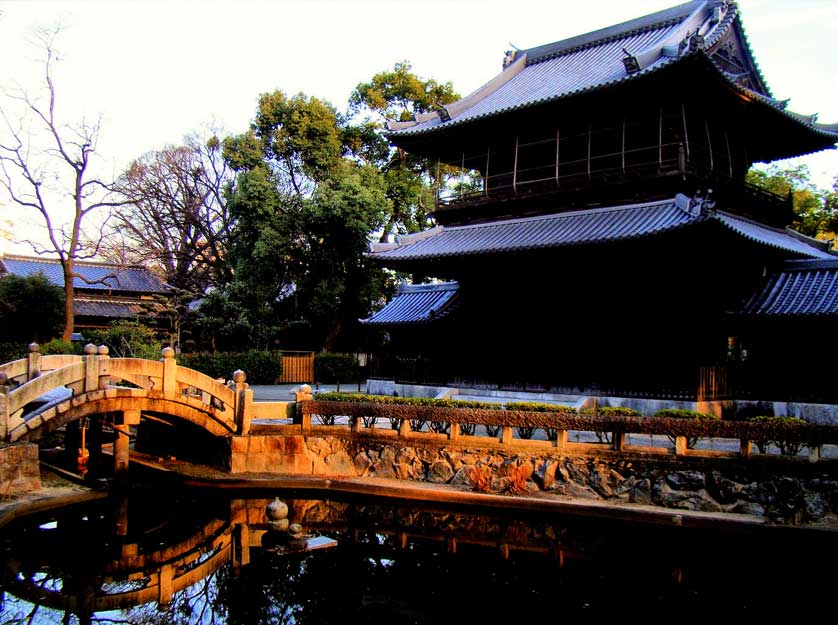
Temple building and bridge at Shofukuji Temple, Fukuoka.
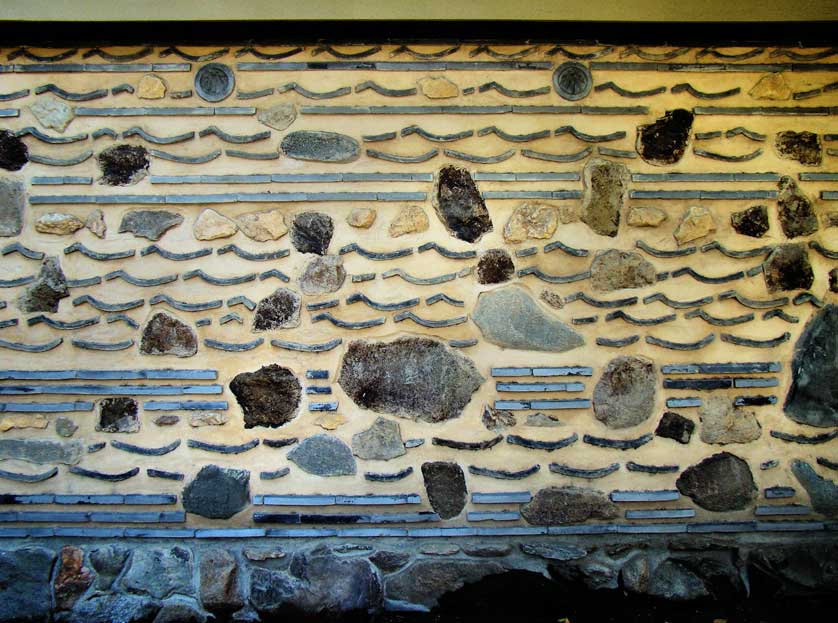
Decorative wall at Shofukuji Temple, Fukuoka, Kyushu.
Cultural treasures and national designations at Shofukuji
Despite the ravages of time and historical upheavals, Shofukuji Temple has managed to preserve a remarkable collection of cultural treasures, many of which have earned national recognition for their historical and artistic significance. These artifacts not only enhance our understanding of the temple's rich history but also provide valuable insights into the development of Zen Buddhism and Japanese art.
One of the most notable treasures housed at Shofukuji is the statue of the 6th Patriarch Daikan Zenji, a figure of immense importance in the lineage of Zen Buddhism. This statue, along with several other artifacts within the temple, has been designated as a National Important Cultural Property, reflecting its exceptional artistic merit and historical value.
The temple also possesses a collection of writings and drawings by the Zen monk Senga Osho, a unique figure from the Bunka and Bunsei eras of Japan (early 19th century). Renowned for his artistic works that often conveyed messages of spiritual salvation, Senga Osho's creations offer a fascinating glimpse into the intersection of Zen philosophy and artistic expression during this period.
In the Buddha Hall, visitors can admire the "Sanzebutsu" (Buddha in the three worlds: past, present, and future), a masterpiece created by the monk Eshin Sozu. This triptych, featuring the Buddhas Shaka, Amida, and Miroku, exudes a sense of timeless serenity and serves as a focal point for meditation and contemplation.
The temple's historical significance extends beyond its art and artifacts. In 1969, the entire precincts of Shofukuji were designated as a National Historic Site, recognizing the temple's unique position as Japan's first Zen temple and its exemplary layout that typifies Zen temple architecture. This designation ensures the preservation of Shofukuji's physical structure and landscape for future generations to study and appreciate.
Additionally, the temple grounds house several other elements of historical interest:
- A framed tablet above the Sanmon Gate, bearing calligraphy by Emperor Go-Toba, proclaiming Shofukuji as "The First Zen Temple" in Japan.
- The aforementioned Hakata-bei walls, which are considered a valuable property due to their rarity and historical significance.
- A cemetery containing the graves of notable figures, including the 32nd Prime Minister of Japan, Koki Hirota, and the politician Taketora Ogata.
While many of these treasures are not always on public display due to preservation concerns, special exhibitions are occasionally held at the Fukuoka City Museum, allowing visitors to appreciate these priceless artifacts up close. These exhibitions serve as a testament to Shofukuji's enduring cultural importance and its role in preserving Japan's rich Buddhist heritage.
The role of Shofukuji in Hakata's development and diplomacy
Shofukuji Temple played a pivotal role in shaping the development of Hakata and its significance as a center for international trade and diplomacy. As the first Zen temple in Japan, Shofukuji quickly became a focal point for cultural exchange and intellectual pursuits, attracting monks, scholars, and diplomats from across East Asia.
At its peak, Shofukuji boasted an impressive 38 sub-temples and chapels in addition to its seven main halls, making it the central religious institution in Hakata. This expansive complex not only served spiritual needs but also fostered the growth of a vibrant community around it. Within the temple grounds, a market town known as "Kannai" flourished, leaving its mark on the urban landscape of Hakata. Even today, many place names in modern Hakata - such as Fugendo, Nakakoji, Uomachi, Amaya, Hasuike, and Nishimon - reflect the buildings and features of this historical settlement.
Shofukuji's influence extended far beyond its immediate surroundings. The temple became a crucial point of contact for diplomatic negotiations, particularly with China. Its strategic location in Hakata, a port city with strong ties to the continent, made it an ideal setting for international relations. The temple grounds even housed the office of the Chinzei Bugyo, the shogunate's official representative for Kyushu, further cementing its importance in regional governance and diplomacy.
One of Shofukuji's most significant contributions to diplomacy was its role in producing bilingual monks who could facilitate communication between Japan and China. These linguistically skilled monks played a crucial role in fostering understanding between the two cultures and facilitating trade relations. This tradition of cultural exchange made Shofukuji a key institution in the broader network of Japanese religious landscape, connecting Japan with the wider Buddhist world.
The temple's influence on Hakata's development was not limited to diplomacy and trade. As a center of learning and culture, Shofukuji contributed significantly to the intellectual and artistic life of the region. The Zen practices introduced at Shofukuji, with their emphasis on discipline, meditation, and direct experience, resonated strongly with the samurai class. This connection between Zen and the warrior elite would have far-reaching effects on Japanese culture, influencing everything from martial arts to the tea ceremony.
Moreover, Shofukuji's founder, Eisai, is credited with introducing tea cultivation to Japan, having brought back tea seeds from China. This seemingly small act would have profound implications for Japanese culture, eventually leading to the development of the sophisticated tea ceremony that is now synonymous with Japanese refinement and hospitality.
Through its multifaceted roles in religion, diplomacy, trade, and culture, Shofukuji Temple served as a catalyst for Hakata's growth into a cosmopolitan center of international importance. Its legacy continues to influence the city's character and its connections with the wider world to this day.
Destruction, revival, and changes throughout the centuries
The history of Shofukuji Temple is one of resilience and renewal, marked by periods of destruction and subsequent revival that mirror the tumultuous history of Japan itself. Despite facing numerous challenges over the centuries, the temple has consistently managed to rise from the ashes, adapting to changing times while maintaining its core identity as Japan's first Zen temple.
One of the most devastating periods for Shofukuji came during the Sengoku period (1467-1615), an era of widespread civil war and social upheaval. In 1563, the temple was destroyed by fire amidst the conflicts that engulfed the region. This destruction was part of a larger pattern of warfare between rival clans, including the Mori, Otomo, and Shimazu, which left much of Hakata in a state of despair.
Although efforts were made to revive the temple in 1570, these proved short-lived. By 1574, Shofukuji had once again fallen into disrepair, with many of its structures completely disappearing. This period of decline coincided with broader changes in Japan's political landscape, as the country moved towards unification under the leadership of powerful warlords.
A significant turning point in Shofukuji's fortunes came in 1587, with the reconstruction of Hakata under the auspices of Toyotomi Hideyoshi, the preeminent daimyo of the time. While this urban renewal project led to a considerable reduction in the temple's precincts, it also set the stage for Shofukuji's revival. The daimyo Kobayakawa Takakage donated additional land to the temple, and under his protection, many structures were rebuilt.
This period of reconstruction continued into the early Edo period (1603-1867). In 1595, Toyotomi Hideyoshi granted additional territory to the temple, a gesture that was repeated by Kuroda Nagamasa in 1600. These land grants helped to secure Shofukuji's position and resources, allowing for further expansion and renovation of its facilities.
The Edo period also saw changes in Shofukuji's sectarian affiliation. Originally an independent temple of the Rinzai school of Zen, it became part of the Kennin-ji sect after its founder Eisai established Kennin-ji in Kyoto. Later, by order of Kuroda Nagamasa, Shofukuji was transferred to the Myoshin-ji sect, an affiliation that continues to the present day.
The modern era brought new challenges and changes to Shofukuji. During the Meiji period (1868-1912), the temple faced difficulties due to the government's policies of separating Shinto and Buddhism (shinbutsu bunri). This period saw the decline of many Buddhist institutions across Japan, and Shofukuji was not immune to these pressures.
The most recent and perhaps most severe destruction came during World War II, when much of Fukuoka, including Shofukuji, suffered extensive damage from U.S. air raids. In the aftermath of the war, the temple's grounds were significantly reduced, consolidating to about a fifth of their former area.
Despite these setbacks, Shofukuji has consistently demonstrated a remarkable ability to recover and adapt. Reconstruction efforts began as early as 1895 and continued well into the post-war period. In recent years, the temple has undergone further renovations and changes, including the expansion of the short stairway (sandō) from the street to the temple portal in 2014.
Today, while smaller than its historical peak, Shofukuji continues to stand as a living monument to the enduring spirit of Zen Buddhism in Japan. Its survival through centuries of change and challenge is a testament to the deep cultural and spiritual significance it holds, not just for the people of Hakata, but for all of Japan.
Visiting Shofukuji Temple: access, hours, and etiquette
For those wishing to experience the tranquil atmosphere and rich history of Shofukuji Temple, a visit to this historic site is both accessible and rewarding. Located in the heart of Fukuoka city, Shofukuji is easily reached by public transportation and offers visitors a peaceful retreat from the bustling urban environment.
Shofukuji Access: The temple is conveniently situated just a short distance from major transportation hubs:
- From JR Hakata Station: A 15-20 minute walk or a quick subway ride.
- By Subway: Take the Fukuoka subway to Gion Station. Shofukuji is just a 3-5 minute walk from Exit 4 of the station.
- Address: 6-1 Gokusho-machi, Hakata-ku, Fukuoka, 812-0037
- For those using GPS or maps: Shofukuji Temple Map
Hours and Admission:
- The temple grounds are open to the public year-round.
- Visiting hours are generally from dawn to dusk.
- Admission to the grounds is free.
It's important to note that while visitors can freely explore the temple grounds, the interior of most buildings is not open to the public. However, you can still appreciate the architecture and atmosphere from the outside.
Etiquette for Visitors:
When visiting Shofukuji, as with any religious site in Japan, it's important to observe proper etiquette to show respect for the temple and its traditions:
- Dress modestly: While there's no strict dress code, it's considerate to wear clothing that covers your shoulders and knees.
- Be quiet and respectful: Remember that this is an active place of worship. Keep your voice low and avoid disruptive behavior.
- Photography: While photography is generally allowed on the grounds, be mindful of any signs indicating restricted areas. Avoid using flash inside buildings if permitted to enter.
- Don't touch or climb on structures: Many of the buildings and statues are very old and culturally significant. Admire them from a respectful distance.
- Follow the paths: Stick to designated walkways and don't venture into restricted areas.
- Respect nature: The temple grounds include carefully maintained gardens. Don't pick flowers or damage plants.
What to See:
While exploring Shofukuji, be sure to take in these key features:
- The imposing Sanmon Gate with its historic plaque
- The serene pond and bridge in front of the Sanmon Gate
- The exterior of the Butsuden (Buddha Hall)
- The unique Hakata-bei walls
- The peaceful cemetery, which includes graves of notable historical figures
- The overall layout of the temple grounds, which exemplifies classic Zen temple design
Seasonal Considerations:
While Shofukuji is beautiful year-round, certain seasons offer unique experiences:
- Spring: Cherry blossoms add splashes of color to the temple grounds.
- Autumn: The changing leaves create a picturesque backdrop for the temple buildings.
- New Year: Many Japanese visit temples during the first days of the year for hatsumode (first shrine visit), creating a lively atmosphere.
For those interested in deepening their understanding of Japanese Buddhism, consider visiting other nearby religious sites such as Kushida Shrine or exploring the broader context of Japan Temples & Shrines.
A visit to Shofukuji offers a unique opportunity to step back in time and experience the birthplace of Japanese Zen. Whether you're a history enthusiast, a spiritual seeker, or simply curious about Japanese culture, Shofukuji Temple provides a tranquil space for reflection and appreciation of Japan's rich Buddhist heritage.
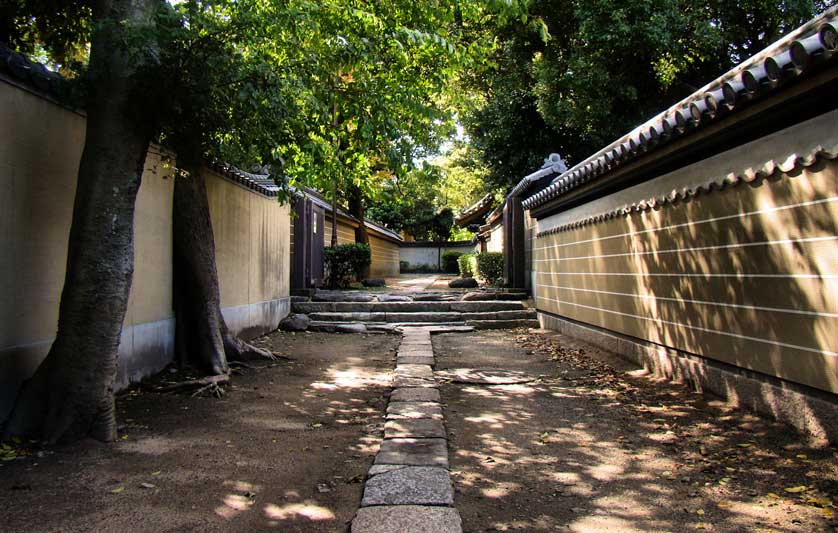
The legacy of Shofukuji and its impact on Japanese Zen Buddhism
The legacy of Shofukuji Temple extends far beyond its physical boundaries, profoundly shaping the course of Zen Buddhism in Japan and influencing Japanese culture at large. As the first Zen temple established on Japanese soil, Shofukuji stands as a pivotal point in the country's religious and cultural history, marking the beginning of a tradition that would come to define much of what the world associates with Japanese aesthetics and philosophy.
The introduction of Zen through Shofukuji represented a significant shift in Japanese Buddhist practice. Unlike the more esoteric and ritualistic forms of Buddhism that preceded it, Zen emphasized direct experience, meditation, and the potential for sudden enlightenment. This approach resonated deeply with many in Japan, particularly the samurai class, who found in Zen a spiritual discipline that complemented their martial training.
The influence of Shofukuji and the Zen tradition it inaugurated can be seen in numerous aspects of Japanese culture:
- Arts and Aesthetics: Zen principles of simplicity, asymmetry, and appreciation of natural beauty profoundly influenced Japanese arts, from calligraphy and ink painting to garden design and architecture.
- Tea Ceremony: The ritualized preparation and drinking of green tea, which Eisai helped introduce to Japan, became a quintessential expression of Zen aesthetics and philosophy.
- Martial Arts: Many traditional Japanese martial arts incorporate Zen concepts of mindfulness, discipline, and the unity of body and mind.
- Literature: Zen-inspired poetry, particularly haiku, with its emphasis on direct experience and present-moment awareness, became a significant form of Japanese literary expression.
Beyond its cultural impact, Shofukuji played a crucial role in the institutional development of Zen in Japan. As the first of its kind, it served as a model for subsequent Zen temples, influencing their architectural layout and organizational structure. The success of Shofukuji paved the way for the establishment of other major Zen institutions, such as Kenninji in Kyoto, also founded by Eisai.
The legacy of Shofukuji is also evident in the broader spread of Zen throughout Japan. From its beginnings in Hakata, Zen Buddhism gradually spread across the country, establishing major centers in Kyoto, Kamakura, and other cities. This dissemination was facilitated by the networks of trade and cultural exchange that Shofukuji helped establish, particularly with China.
In the realm of intellectual and spiritual development, Shofukuji's legacy is profound. The temple became a center for the study and practice of Zen, producing generations of monks who would go on to shape the development of Japanese Buddhism. The emphasis on direct transmission from master to disciple, a hallmark of Zen practice, ensured that the teachings and methods introduced at Shofukuji were preserved and passed down through the centuries.
Even today, centuries after its founding, Shofukuji continues to play a role in the ongoing evolution of Zen in Japan. As part of the Myoshin-ji branch of Rinzai Zen, it remains an active center of practice and study. The temple serves as a living link to the origins of Japanese Zen, offering both practitioners and visitors a tangible connection to this rich spiritual tradition.
For those seeking to deepen their understanding of Zen and its place in Japanese culture, Shofukuji provides an unparalleled historical context. Whether through its architecture, its artifacts, or simply the atmosphere of its grounds, the temple offers insights into the foundational principles of Zen and their enduring relevance in contemporary Japan.
As Japan continues to navigate the complexities of modernity, the legacy of Shofukuji reminds us of the enduring power of spiritual traditions to shape culture and provide meaning. In a fast-paced world, the principles of mindfulness, simplicity, and direct experience that Shofukuji embodies offer a timeless source of wisdom and balance.
For those interested in exploring this legacy further, a visit to Shofukuji can be complemented by reading about the broader context of Zen in Japan. Resources such as Books on Japan & Japanese Temples offer valuable insights into the historical and cultural significance of temples like Shofukuji and their place in the rich tapestry of Japanese spirituality.
In conclusion, Shofukuji Temple stands not just as a historical monument, but as a living testament to the profound impact of Zen on Japanese culture. Its legacy, stretching from the 12th century to the present day, continues to inspire and influence, reminding us of the enduring power of spiritual traditions to shape our world and our understanding of ourselves.
